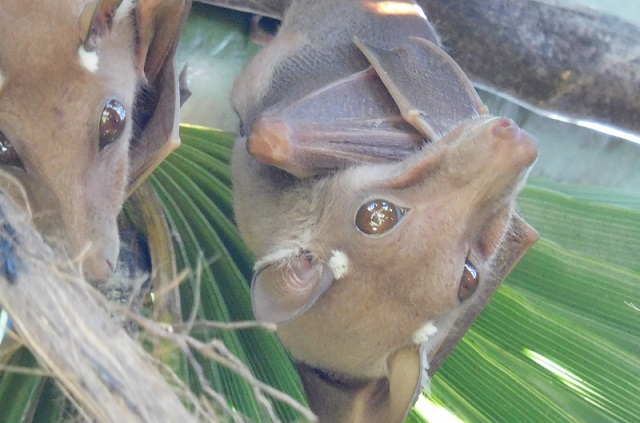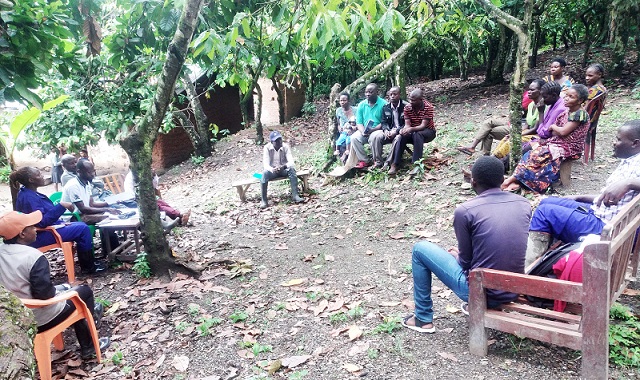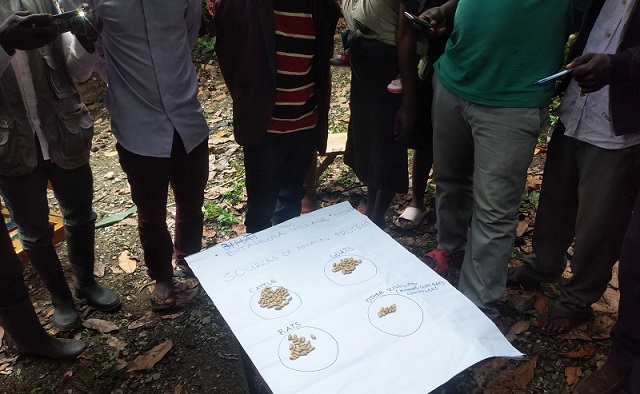
Hunt for Ebola in the Rwenzori mountains turns into discussion of nutrition, love, and sex
The United States Agency for International Development (USAID) is funding a five-year project known as the “Strategies to Prevent Spillover” in seven priority African and Asian countries whose aim is to strengthen their capacities to identity, assess and monitor risks associated with emerging zoonotic viruses like Ebola. The ultimate objective of the project is designing proven and new risk reduction measures.
In Uganda, this project is being implemented in the mountainous district of Bundibugyo which was identified as one of the hotspots of viral diseases thanks to its proximity to the Democratic Republic of Congo but also because it has communities of people who eat bats.
Funded under USAID’s Global One Health Security programme, Makerere University researchers under their Africa One Health University Network (AFROHUN), a partner of the US-based Tufts University, have over the last two years been working on an ecological study aimed at gauging the local communities’ knowledge levels on bats and their potential to transmit dangerous diseases. The Independent’s Ronald Musoke recently accompanied the researchers on some of their excursions.
*****
The STOP Spillover project has several technical leads. One hub of researchers is looking at surveillance, mapping and modelling of the bat populations in the district while another is looking at how best to protect food and water resources from bat contamination. Another is looking at risk analysis and communication to enable the project design interventions that will eventually protect communities from outbreaks of dangerous pathogens such as Ebola.
“We know for certain that most of the dangerous pathogens originate from our environment and animals (and) these cause what we call zoonotic diseases such as Ebola,” Dr Charles Drago Kato who is the technical lead for surveillance, modelling and mapping hub of the STOP Spillover project in Uganda told The Independent as we embarked on our fieldwork.
“What the STOP Spillover project wants to do is for the pathogen to stay in the bats because we know that when it crosses into humans it can be catastrophic,” he added.
Dr. Kato, who also lectures at Makerere University’s Department of Biotechnical and Diagnostic Sciences in the College of Veterinary Medicine, Animal Resources and Biosecurity, said the other objective is to prevent its spread as soon as possible, if a pathogen leaves the bat and crosses into the human population.
When the researchers who are working in three sub-counties of Harugale, Burondo and Ntandi town council first visited and interacted with the communities in Bundibugyo a couple of years ago, the bat-human interface stood out strongly for the viral pathogens, said James Muleme, a public health expert who works on the project as the technical lead for the food, water and air hub.
“We carried out an outcome mapping where we invited local stakeholders to share views on the bat-human interface and among the many areas that came up was the protection of food and water resources from bat contamination.”
Among the researchers’ activities in the district are interactions with people in the communities. They visit homes to assess the capacity of the people to take on any intervention but also their willingness to adopt best practices. “The whole exercise is referred to as the “trials of improved practices,” Dr. Kato told The Independent.
Bats as vermin
In one of these exercises, The Independent tags along a small group of data collectors. We are visiting 50-year-old Agnes Masika whose home is up in the Rwenzori Mountains in a village known as Kabingo III in Kihoko Parish, Harugale sub-county.
Even by Bundibugyo District’s rugged terrain standards, reaching Masika’s home requires us to summon all the energy in our bodies to make it. The data collector, Divine Katiti, wants to see Masika’s home and probe her about her daily lifestyle.
Is her home prone to bat infestation? How does she keep her water and food safe from bat contamination? Masika who lives in a two-bedroom mud and wattle house on about two acres of arable land says bats are among the most notorious vermin in her home and village.
“If you don’t cover your food very well, bats can contaminate it. Sometimes, if you leave the doors open, the bats can enter and access the food and water,” she tells the youthful data collector who punches her findings in a phone specifically purposed for the project.
Masika says bats also drink and bathe in the nearby stream which serves three villages with drinking water. This is often the case when these flying mammals eat sweet fruits. They often nibble at pawpaw, ripe bananas, passion fruit, apples, guavas, avocado and even coffee berries. The only crop spared is cocoa, possibly because of the tough pods.
“For cooked food, if we find fur or toe-prints, we throw it away because we want to avoid diseases from these bats. We have been told by health workers that bats can bring Ebola and so we try to cover our food and water,” she says.
Interestingly when it comes to fresh fruit, Masika says the handling is different.
“We normally cut off the bitten part and we eat the rest,” she says with an embarrassed smile. She says this is more likely when she is in her garden. “I eat the fruits unwashed because water is often not nearby the garden and I cannot wait.”

“We sometimes eat these fruits bitten by the bats; sometimes if the bitten portion is small, we cut it away and eat the rest but if it is big, we throw it away.”
Bats are everywhere in Masika’s village. They live under rocks, in caves, and along the river banks that gush down the mountains. Some bats are so audacious that they inhabit some people’s homes.
Masika takes us to the nearby spring where people from the surrounding three villages fetch water for drinking and home use. She explains that some tinier species of bats know how to hide inside the water pipe. As we end the interview and descend the mountains amidst a looming late morning downpour with Masika in tow, we are under the impression that the villagers here view the bats as a menace to the community.
But that impression does not last long.
Bats as a treasure
Along the way, Masika stops to greet Zepher Bwambale, the LC Chairman of Kabingo II; a village which is below Masika’s. She introduces us to him and in our quick chat with him, Bwambale tells us about his community’s association with the bats.
One of the beliefs he has grown up listening to is that eating bats brings several benefits. Bat meat, for example, is used as an aphrodisiac by some men in Bundibugyo, he says.
But it is during another excursion, this time in Ntandi town council, that The Independent learns in detail the communities’ attitude towards bats.
The researchers are in Bitahura I village in Nyabugesera ward, in Ntandi, a small trading centre that sits in between two national parks; Semliki National Park and Rwenzori Mountains National Park. This time, the researchers are going to have a focus group discussion with about 15 locals. The LC I chairman, Muhindo Kigoma and his deputy, William Bwambale, are in attendance.
Chairman Kigoma begins by giving an overview of his village and its daily challenges among which is food insecurity owing to the fact that most of their arable land is under the cash crop, cocoa, which does not support intercropping. It is not so long that he delves into the issue of bats. He unflinchingly tells the researchers that the people in his community happily eat bats.
“We didn’t just start eating bats yesterday; our grandparents ate them; we eat them and we shall continue eating them,” he says. Kigoma explains the reasons why his community takes bats as a delicacy.
“We eat bats because they work as medicine; bat meat gives us strong blood (immunity). Culturally, we use the bat fingers in love portions. If you use them, you cannot leave your partner. Just like the bat holds onto a tree branch tightly, your partner too holds onto you. If a child eats the head of the bat, he or she becomes very smart in class.”
“The women here say eating bats gives them a smooth skin. For the sickly children, they are fed on bat soup but also the mothers can pick a tooth of a bat, put it on a thread and tie at around the baby’s waist and all diseases will disappear,” Kigoma says.
It is a chilling revelation as the researchers were visiting the village in the middle of an Ebola outbreak in the central western district of Mubende. And in this very district, there was an Ebola outbreak in 2007 which infected over 130 people and killed 42 people.
But, with a whimsical stare, Kigoma tells the researchers that bats are like any other animal such as goats and cattle that may carry disease causing pathogens.
“But we have never seen people stop eating goat or cow meat.” “The way you see chicken in your home is the way we see the bats here,” he says, adding that bat meat can be mixed with beans or groundnut sauce.
“The bats are either birds or animals. So, we prepare the bats like we would a goat (skinning and removing its entrails). For small ones, we could harvest about 12-15 but the bigger species, one or two are enough for a family.” He says a typical household in his community comprises six to seven people.
Kigoma takes us up in the mountains to show us a cave which has been colonized by bats. The cave is in his land so he claims the bats are his. He says he sometimes sells them for a small fee ranging between Shs 2000 and Shs 5000.
He says the only challenge the communities find with the bats is with those that live inside people’s houses. “The bats that stay indoors destroy clothes; their fecal matter and urine makes the house smell terrible,” he says.
But the people here also believe bats are often used by sorcerers as means of transport for witchcraft.
“When the bats get inside one’s house, it is important that it does not get your hair on the head.
“When a sorcerer picks one’s hair, it is the beginning of the end of one’s life,” Kigoma says, “Even if they take you to the best hospitals to examine you, they will not find any disease but you will actually feel sick.”
‘Clueless scientists’
Zefa Baluku Kesokake who says he is a peasant farmer and complements it with hunting in the nearby game parks says the scientists blaming bats for Ebola are merely guessing. Uganda has experienced many Ebola outbreaks but the experts have failed to find the real cause of Ebola, he says.

“We hear there is Ebola Sudan, Ebola Zaire and now there is Ebola in Mubende. How come the scientists have never found what exactly causes Ebola?
“Yes, we worry about Ebola in our community but we don’t believe that bats are responsible for causing it. We were told in 2007 that someone ate a monkey while others said, someone ate a bat but we tried to trace for the victim household but we failed,” adds William Bwambale, the village’s vice chairman.
“That is why we don’t believe in the science behind Ebola. When we suspect a bat to be sick, we can’t eat it; just like you can tell a sickly chicken we too can tell a sickly bat.
“Yes, the outbreak happened but as soon as it stopped, we resumed eating our bats and no one has fallen sick. Show me one person who ate a bat and got sick,” Bwambale says.
However, Dr. Kato later told The Independent that animals that are presumed to carry Ebola might not look sickly because the virus might not affect them; they are simply carriers of the Ebola virus.
Searching for alternatives
As the researchers conclude their interaction with this group, James Robert Ochieng, a researcher based at the Department of Zoology, Entomology and Fisheries Sciences, College of Natural Sciences in Makerere University who is working on this project as a research assistant interjects and explains to the group that it is still difficult for scientists to conclude whether bats are responsible for spreading Ebola because no scientific proof exists.
“We cannot yet put on paper that bats are carriers of Ebola. So, our work as researchers is to look for evidence of their role in disease transmission, if any.”
The group is then told to get into a hurdle for a small exercise. A young lady on the team spreads a white manilla paper on a small rectangular table.
On the paper, four circles have been drawn; representing sources of animal protein; cattle, goats, bats and other wild game. The group is asked to put as many beans as possible in the circle to show how much the community consumes certain animal protein.
By the end of the exercise; cow meat takes 41%, followed by goat meat (26%), bats (23%) while 9% is taken up by the rest of wild game. The group says cattle meat ranks highest because it is readily available all year round but it is out of reach for the majority of households. In a separate interview, Dr. Shamilah Namusisi, a veterinary and public health expert working on the Stop Spillover project as the technical lead for risk analysis communication hub told The Independent that the researchers are dealing with deep-seated cultural issues.
“One of our strategies is to design a socio-behavioural change strategy to see how we can influence these communities,” she says, “It will definitely take a bit of time because the communities have expressed several concerns about them getting weaned off bat meat.”
Dr. Namusisi says in several discussions, people ask them for an alternative if eating bats is risky.
“So, if this is a risk-survival issue, what’s the alternative that is available to the communities? In many cases, it (eating bats) is driven by culture but also livelihoods; people have limited resources to depend on,” she says.
She says these issues should come up in the discussions on global health security. “We cannot be talking about global health (security) when people at community level are pressed with livelihoods concerns,” she says, “These concerns must come to the table.”
She says discussions about fighting diseases that spill over into humans from animals must also think about providing alternative livelihoods to people in these communities. “Ultimately, lack of survival alternatives is driving the emergency of these zoonotic diseases,” she says.
 The Independent Uganda: You get the Truth we Pay the Price
The Independent Uganda: You get the Truth we Pay the Price



